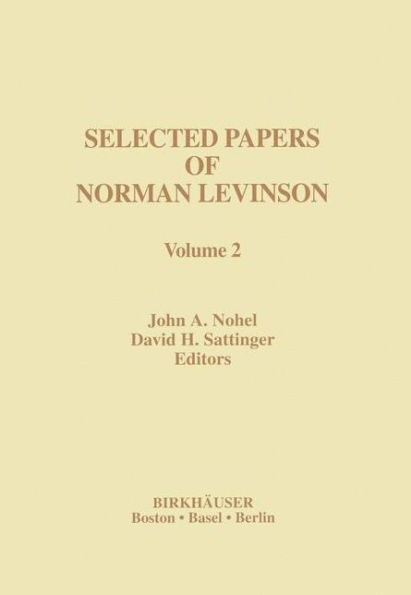Table of Contents
- Volume 2.- VIII. Harmonic and Complex Analysis1.- Commentary on Gap and Density Theorems by Raymond Redheffer.- [L 8] On the Closure of $$\left\{ {{esub{i{\lambda _n}x}}} \right\}$$ (1936).- [L 7] On a Class of Non-Vanishing Functions (1936).- [L 9] On a Problem of Pólya (1936).- [L 10] On Certain Theorems of Pólya and Bernstein (1936).- [L 11] On Non-Harmonic Fourier Series (1936).- [L13] A Theorem Relating Non-Vanishing and Analytic Functions (1938).- [L 14] On the Growth of Analytic Functions (1938).- [L 15] General Gap Tauberian Theorems: I (1938).- [L 17] Restrictions Imposed by Certain Functions on Their Fourier Transforms (1940).- [L 74] Transformation of an Analytic Function of Several Variables to a Canonical Form (1961).- [L 82] Absolute Convergence and the General High Indices Theorem (1964).- [L 107] (with R. M. Redheffer) Schur’s Theorem for Hurwitz Polynomials (1972).- [L 115] On the Szasz-Müntz Theorem (1974).- IX. Shastic Analysis.- Commentary on [L 33], [L 34], [L 69], [L 70] and [L 81] by Mark Pinsky.- [L 33] The Wiener RMS (Root Mean Square) Error Criterion in Filter Design and Prediction (1947).- [L 34] A Heuristic Exposition of Wiener’s Mathematical Theory of Prediction and Filtering (1947).- [L 69] Limiting Theorems for Galton-Watson Branching Process (1959).- [L 70] Limiting Theorems for Age-Dependent Branching Process (1960).- [L 81] (with H. P. McKean, Jr.) Weighted Trigonometrical Approximation on R1 with Application to the Germ Field of a Stationary Gaussian Noise (1964).- X. Elementary Number Theory and the Prime Number Theorem.- [L 98] A Motivated Account of an Elementary Proof of the Prime Number Theorem (1969).- [L 109] On the Elementary Character of Wiener’s General Tauberian Theorem (1973).- XI. The Riemann Zeta-Function.-XI. 1 Zeros on the Critical Line.- Commentary on [L 112], [L 113], [L 116], [L 117], [L 118], [L 120], [L 121] by Brian Conrey.- [L 19] On Hardy’s Theorem on Zeros of the Zeta Function (1940).- [L 64] On Closure Problems and the Zeros of the Riemann Zeta Function (1956).- [L 99] Zeros of the Riemann Zeta-Function near the 1-Line (1969).- [L 103] On Theorems of Berlowitz and Berndt (1971).- [L 112] More than One Third of Zeros of Riemann’s Zeta-Function are on— = 1/2 (1974).- [L 113] Zeros of Derivative of Riemann’s—-Function (1974).- Corrigendum (1975).- [L 116] At least One-Third of Zeros of Riemann’s Zeta-Function are on— = 1/2 (1974).- [L 117] Generalization of Recent Method Giving Lower Bound for N0(T) of Riemann’s Zeta-Function (1974).- [L 118] (with H. L. Montgomery) Zeros of the Derivatives of the Riemann Zeta-Function (1974).- [L 120] A Simplification of the Proof that >N0(T) > (1/3)N(T) for Riemann’s Zeta-Function (1975).- [L 121] Deduction of Semi-Optimal Mollifier for Obtaining Lower Bound for >N0(T) of Riemann’s Zeta-Function (1975).- XI.2 Omega Results for the Riemann-Zeta Function.- Commentary on [L 104] by Brian Conrey.- [L 104]?-Theorems for the Riemann-Zeta Function (1972).- XI.3 Other Papers on the Riemann Zeta-Function.- [L 108] Remarks on a Formula of Riemann for his Zeta Function (1973).- [L 111] Asymptotic Formula for the Coordinates of the Zeros of Sections of the Zeta Function,?N (s), near s = 1 (1973).- [L 122] Almost All Roots of—(s) = a Are Arbitrarily Close to— = 1/2 (1975).- [L 123] On the Number of Sign Changes of—(x)—li x (1976).- XII. Miscellaneous Topics.- Commentary on [L 91] by John Nohel and Héctor Sussman.- Commentary on [L 114] by Alladi Ramakrishnan.- [L 12] (with G. H. Hardy), Inequalities Satisfiedby a Certain Definite Integral (1937).- [L 79] Generalization of an Inequality of Ky Fan (1964).- [L 83] Generalizations of an Inequality of Hardy.- [L 91] Minimax, Liapunov and “Bang-Bang” (1966).- [L 92] Linear Programming in Complex Space (1966).- [L 93] A Class of Continuous Linear Programming Problems (1966).- [L 114] On Ramakrishnan’s Approach to Relativity (1974).



